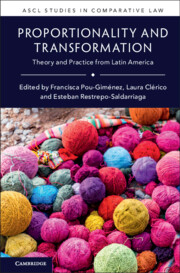Book contents
- Proportionality and Transformation
- Ascl Studies in Comparative Law
- Proportionality and Transformation
- Copyright page
- Contents
- Editors
- Contributors
- Acknowledgments
- Introduction
- Part I Proportionality and Processes of Constitutionalization
- 1 The Standard Reasonableness Test and Proportionality in Argentina
- 2 Proportionality in the Case Law of the Constitutional Court of Ecuador
- 3 Proportionality and Human Rights in Mexico
- 4 Proportionality and the Construction of Democracy
- 5 Proportionality in the Case Law of the Chilean Constitutional Court
- Part II Proportionality in Social Rights and Equality-Based Adjudication
- Part III Proportionality, between Transformation and the Status Quo
- Index
4 - Proportionality and the Construction of Democracy
Notes from the Peruvian Jurisprudence
from Part I - Proportionality and Processes of Constitutionalization
Published online by Cambridge University Press: 27 October 2022
- Proportionality and Transformation
- Ascl Studies in Comparative Law
- Proportionality and Transformation
- Copyright page
- Contents
- Editors
- Contributors
- Acknowledgments
- Introduction
- Part I Proportionality and Processes of Constitutionalization
- 1 The Standard Reasonableness Test and Proportionality in Argentina
- 2 Proportionality in the Case Law of the Constitutional Court of Ecuador
- 3 Proportionality and Human Rights in Mexico
- 4 Proportionality and the Construction of Democracy
- 5 Proportionality in the Case Law of the Chilean Constitutional Court
- Part II Proportionality in Social Rights and Equality-Based Adjudication
- Part III Proportionality, between Transformation and the Status Quo
- Index
Summary
This chapter explores the emergence (not always explicit), the uses and the misuses of proportionality analysis during a crucial period of Peruvian democracy: the transition of the 2000s, following the collapse of the Fujimori regime. The history of the principle of proportionality in Peru is associated to the development of judicial review and the expansion of constitutionalism. Its increasing presence in judicial reasoning reveals progress in terms of the effectiveness of constitutional rights and the defense of democratic institutions, but also an alarming trend toward its formalistic use. Since the Constitutional Tribunal has been the main actor behind this process, the chapter mainly focuses on its decisions, but some decisions by the Supreme Court and by administrative courts are also covered, given its recurrent use by the judiciary at large and its role in decentralized judicial review, especially in the context of ordinary criminal procedures where the legality of pretrial detention is examined.
Keywords
- Type
- Chapter
- Information
- Proportionality and TransformationTheory and Practice from Latin America, pp. 88 - 109Publisher: Cambridge University PressPrint publication year: 2022

